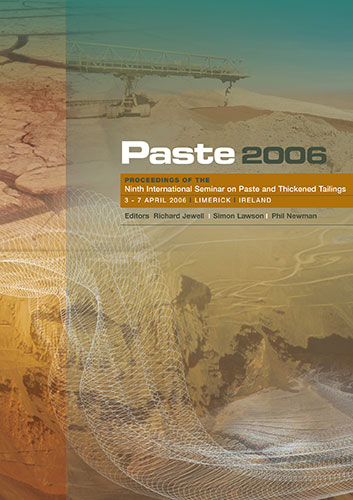Mechanics of Early Age Cemented Paste Backfill

|
Authors: Helinski, M; Fourie, AB; Fahey, M |
DOI https://doi.org/10.36487/ACG_repo/663_27
Cite As:
Helinski, M, Fourie, AB & Fahey, M 2006, 'Mechanics of Early Age Cemented Paste Backfill', in R Jewell, S Lawson & P Newman (eds), Paste 2006: Proceedings of the Ninth International Seminar on Paste and Thickened Tailings, Australian Centre for Geomechanics, Perth, pp. 313-322, https://doi.org/10.36487/ACG_repo/663_27
Abstract:
Between December 2003 and December 2004 there were reportedly at least six paste fill barricade failures worldwide, with each of these failures resulting in an inrush of fill to the mine workings. Many of these failures are considered to be a result of misunderstanding the mechanisms associated with the consolidation of paste fill during placement. This paper outlines the importance of consolidation in assessing mechanisms associated with the early age behaviour of paste fill. To illustrate the importance of consolidation, a series of numerical simulations have been presented, including a completely drained, an undrained and a coupled analysis. As the in situ development of effective stress will be dominated by the rate of consolidation, understanding this behaviour will also assist in replicating in situ curing conditions. A one dimensional consolidation model capable of simulating the consolidation of a cemented paste fill is presented. A parametric study is undertaken to illustrate the influence of consolidation mechanisms specifically related to cemented paste fill. Finally, the model output is compared with a set of in situ pore water pressure (PWP) measurements to illustrate the relevance of the assumed mechanisms.
References:
Aubertin, M., Li, L., Arnoldi, S., Belem, T., Bussiere, B., Benzaazoua, M. and Simon, R. (2003) Interaction between backfill and
rock mass in narrow stopes. Soil and Rock America, Vol.1, pp. 1157-1164.
Bentz, D.P. (1995) Three-dimensional computer simulation of portland cement hydration and microstructure development. J Am
Ceram Soc 80.
Belem, T., Benzaazoua, M., Bussiere, B. and Dagenais, A.M. (2002) Effect of settlement and drainage on strength development
within mine paste backfill. Tailings and Waste ’02.
Blight, G.E. (2000) The use of mine waste as structural underground support. Geoeng 2000, Melbourne.
Brouwers, H.J.H (2003) The work of Powers and Brownyard revisited: Part1. Cement and Concrete Research, Vol. 34, pp. 1697-
1716.
Carter, J.P. and Liu, M.D. (2005) Review of the structured Cam Clay model., Soil Consitiutive Models: Evaluation, Selection and
Calibration, ASCE, Geotechnical Special Publication No 128, pp. 99-132.
Consoli, N.C., Rotta, G.V. and Perietto, P.D.M. (2000) Influence of curing stress on the triaxial response of cemented soils,
Géotechnique, Vol. 50, No 1, pp. 99-105.
Helinski, M., Fourie, A.B. and Fahey, M. (2006) The self-desiccation process in cemented mine backfill. Canadian Geotechnical
Journal (submitted).
Hua, C., Acker, P. and Ehrlacher, A. (1995) Analysis and models of autogenous shrinkage of hardening cement paste. Cement and
Concrete Research, Vol. 25, No. 7, pp. 1457-1468.
Le Roux, K. (2004) In situ properties and liquefaction potential of cemented paste backfill. PhD thesis, Graduate department of civil
engineering, University of Toronto, Canada.
Li, L. and Aubertin, M. (2003) A general relationship between porosity and uniaxial strength of engineering materials. Canadian
Journal of Civil Engineering, 30, pp. 644 -658.
Potvin, Y., Thomas, E. and Fourie, A. (2005) Handbook on Mine Fill, Australian Centre for Geomechanics.
Powers, T.C. and Brownyard, T.L. (1947) Studies of the physical properties of hardened portland cement paste. Bull.22, Res. Lab. of
Portland Cement Association, Skokie, IL, U.S.A., reprinted from J. Am. Concr. Inst. (Proc.), Vol 43 (1947).
Rankine, R.M., Rankine, K.J., Sivakugan, N., Karunasena, W. and Bloss, M. (2001) Geotechnical characterisation and stability
analysis of BHP Cannington paste backfill, Proceedings of 15th ISSMGE, Istanbul, Turkey, 1241-1244, Balkema, Rotterdam.
Rotta, G.V., Consoli, N.C., Perietto, P.D.M., Coop, M.R. and Graham, J. (2003) Isotropic yielding in an artificially cemented soil
cured under stress, Géotechnique 53, No 1, pp. 493-501.
Seneviratne, N., Fahey, M., Newson, T.A. and Fujiyasu, Y. (1996) Numerical modelling of consolidation and evaporation of slurried
mine tailings. International Journal for Numerical and Analytical Methods in Geomechanics, Vol. 20, No. 9, pp. 647–671.
Winch, C.M. (1999) Geotechnical characterisation and stability of paste backfill at BHP Cannington Mine. Undergraduate thesis,
School of Engineering, James Cook University, Australia.
Zuh, F. and Clark, J.I. (1993) The effect of cementation of Ko of sand. Proc of the third International Symposium on Offshore and
Polar Engineering, Singapore, Volume Number 1, pp. 528-533.
322 Paste2006,Limerick,Ireland
MechanicsofEarlyAgeCementedPasteBackfill M.Helinski,etal.
© Copyright 2025, Australian Centre for Geomechanics (ACG), The University of Western Australia. All rights reserved.
View copyright/legal information
Please direct any queries or error reports to repository-acg@uwa.edu.au
View copyright/legal information
Please direct any queries or error reports to repository-acg@uwa.edu.au